Edie Melson's Blog, page 196
June 25, 2020
10 Components of a Successful Facebook Live Book Launch Party
 By Lori Hatcher @LoriHatcher2
By Lori Hatcher @LoriHatcher2In April’s post, “5 Reasons You Should Host a Facebook Live Book Launch Party – Pandemic or Not,” I shared how my in-person launch party for Refresh Your Faith, Uncommon Devotions from Every Book of the Bible suddenly morphed into a Facebook Live book launch party because of the nationwide shelter-at-home order.
In May’s post, “15 Tips for Hosting a Successful Facebook Live Book Launch Party,” I gave you my best suggestions for a stellar virtual event.
Today, I’d like to share ten components of a successful Facebook Live Book Launch Party.
1. Use an agenda and script. There’s no need to write a word-for-word script. You’ll appear more natural and conversational if your eyes are on the camera, not on your notes. You will want to make sure you have an order of events, an engaging opening, and a strong close. A cheat sheet will help you with nervousness and brain freeze, keep you on track, and eliminate dead spots in the broadcast.
2. Begin with a strong hook. Because you’ll post the video on your page after the party, viewers who didn’t attend will encounter your video while scrolling through their feed. The first minute of footage will help them decide if they want to keep watching. Give them a reason to stay.
3. Share the what and the why. Tell viewers why you’re having a party and what they can expect if they stick around. “I’m Lori Hatcher, and we’re here today to celebrate the launch of my new devotional, Refresh Your Faith, Uncommon Devotions from Every Book of the Bible. We’ll be playing games, sharing conversation, and giving away prizes, including several signed copies of my book, gift cards, and other goodies. We’ll laugh, have fun, get to know each other, and be refreshed in our faith.” Repeat this several times throughout the event for people who have just signed on.
4. Explain the giveaways. I awarded an entry for each person who watched, every time they participated in one of the discussions, shared the event on social media, and played a game.
5. Tell people where they can purchase your book. Many publishers will offer a special launch week price if they know you’re planning an event. Ask your publicist. My publisher, Our Daily Bread Publishing, offered a 40 percent discount the week of my launch.
6. Ask several questions that relate to your book’s theme. I asked, “During this shelter-at-home season, have you found it easier or harder to have regular devotions?; and During spiritually-dry times, what have you done to refresh your faith? I awarded an entry into the door prize drawing for each answer.
7. Play a game. I created a “How Well Do You Know the Author?” game with 15 questions about myself with multiple choice answers. Everyone kept track of their own answers, and I awarded a prize for the person who got the most questions correct.
8. Thank those who have helped make the book (and the launch) possible. There’s no nicer way to acknowledge your spouse’s, family’s, friends’, editors’, publishers’, and publishing house’s dedication and commitment than to thank them publically. Mentioning them on air is a great way to send kudos their way.
9. Thank guests for attending. Just like you’d express appreciation to friends for attending an in-person party, thank your viewers for taking time out of their schedule to attend your virtual party. Commend them for joining in the conversation, supporting you on your writing journey, and praying for you. Don’t take their attendance for granted. They could have done a hundred other things during that hour, but they chose to spend it with you.
10. Close in prayer. I asked my pastor/husband to end the evening by asking God to bless the book and those who will read it. Ending with prayer is a sweet way to pay tribute to the God who orders the events of the universe, including the timing of pandemics and book launches.
I never imagined I’d be launching a book in the middle of a pandemic. Proverbs 16:9, “A man’s heart plans his way. But the LORD directs his steps,” brought me comfort as I watched my plans for an in-person party disappear like hand sanitizer and toilet paper.
But God is sovereign. He knows what’s best. Once I surrendered my plans to Him and asked Him to guide me, I realized a Facebook Live party would be the best way to launch my book. Looking back, I’m glad I did. I suspect you might be, too.
Now it’s your turn. What’s the most unusual way you’ve ever launched a book? Share your story and join the conversation.
TWEETABLE
10 Components of a Successful Facebook Live Book Launch Party - @LoriHatcher2 on @EdieMelson (Click to Tweet)
 Lori Hatcher loves to teach, train, and encourage writers by sharing what others have generously shared with her. She’s the author of several devotional books including
Refresh Your Faith – Uncommon Devotions from Every Book of the Bible
and
Hungry for God … Starving for Time, Five-Minute Devotions for Busy Women
, the 2016 Christian Small Publisher Book of the Year. The editor of
Reach Out, Columbia
magazine, she’s also a blogger, writing instructor, and inspirational speaker. You’ll find her pondering the marvelous and the mundane on her blog, Hungry for God. . . Starving for Time . Connect with her on Facebook, Twitter (@LoriHatcher2), or Pinterest (Hungry for God).
Lori Hatcher loves to teach, train, and encourage writers by sharing what others have generously shared with her. She’s the author of several devotional books including
Refresh Your Faith – Uncommon Devotions from Every Book of the Bible
and
Hungry for God … Starving for Time, Five-Minute Devotions for Busy Women
, the 2016 Christian Small Publisher Book of the Year. The editor of
Reach Out, Columbia
magazine, she’s also a blogger, writing instructor, and inspirational speaker. You’ll find her pondering the marvelous and the mundane on her blog, Hungry for God. . . Starving for Time . Connect with her on Facebook, Twitter (@LoriHatcher2), or Pinterest (Hungry for God).
Published on June 25, 2020 22:00
June 24, 2020
Writer, Who Told You That?

by Henry McLaughlin @RiverBendSagas
Remember the old cliché́ from childhood: sticks and stones may break my bones, but names will never hurt me?
Not true. Words and names can actually do much more lasting damage. Cuts and bruises heal. Words and names create self-images that linger and poison for years. They can become prophecies we fulfill whether we want to or not.“You’re no good.”“You’ll never amount to anything.”“You can’t handle money.” “You’re such a slob.”“Why can’t you be like your brother? Or your sister? Or Uncle Fred?”“Whatever made you think you could be a writer?”
How many of us have had these words or something very similar spoken to us? They hurt then, and they still sting now?
Here’s a question to consider: who told you that?
Your mother or father? A teacher or classmate? Your ex-spouse?
The most serious side effect of these negative comments is they become our self-talk. We believe and speak what has been spoken into us.
The next time one of these derogatory or negative phrases comes to mind, start quizzing yourself. Ask yourself, “Who told me that?” Consider the source. They are all flawed humans just like us. They all have their own perceptions and expectations of the world that taint how they see us and how they characterize us.
Then ask yourself, “Who does God say I am?”
His is the only opinion that matters, because his Word is the truth. His Word is the only source for what is true about him, about us, our pasts, our futures, about others, about our enemies, about this world and the next.
Let Psalm 139:14 NKJV be our meditation and our answer. “I will praise You, for I am fearfully and wonderfully made; Marvelous are Your works, And that my soul knows very well.”
His Word is a mirror for us to see ourselves as he sees us.
How would you handle negative comments from your past (or present) knowing who you are in Christ?
TWEETABLEWriter, Who Told You That? - Henry McLaughlin, @RiverBendSagas, on @EdieMelson (Click to Tweet)
 Henry’s debut novel, Journey to Riverbend, won the 2009 Operation First Novel contest.
Henry’s debut novel, Journey to Riverbend, won the 2009 Operation First Novel contest.Henry edits novels, leads critique groups, and teaches at conferences and workshops. He enjoys mentoring and coaching individual writers.
Connect with Henry on his blog, Twitter and Facebook.
Published on June 24, 2020 22:00
June 23, 2020
Writer Skill: Understanding Story Pacing
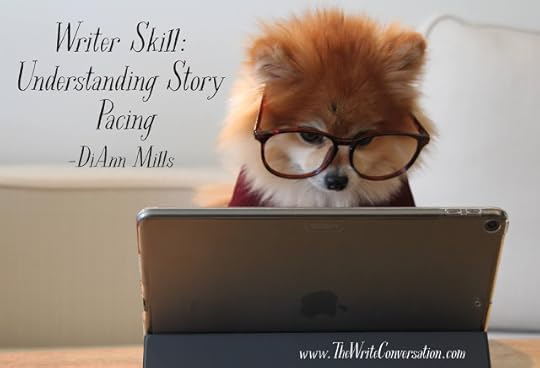
by DiAnn Mills @DiAnnMills
Story pacing is the writer’s ability to move the story ahead with action and reaction. It incorporates the genre, plot, characters, and goal of each scene. Writers strive for varied story structure that balances the mood and emotion with actions and reactions. The technique opens the door to achieving a perfect speed for a story. No writer wants the rhythm of their sentences, paragraphs, and scenes to resemble a metronome. In every genre, the writer uses pacing to lead the reader into story explosions. The genre often determines the pace. Horror, suspense, thrillers, and mystery achieve the desired effect keeping the plot moving ahead with the threat of impending danger. A literary style slows the pacing.
Faster pacing ensues action and uses the scene’s mood to add conflict, tension, and suspense. This keeps the reader engaged. The reader’s heart rate increases, adding emotion to the experience. The speed tells the reader that something exciting is about to happen. Hold on tight! It’s coming!
Here are a few tips to accomplish a faster story pace: Choose an active voice.Create shorter sentences, paragraphs, and scenes. Develop action driven hooks at the beginning and ending of a scene.Enlist snappy dialogue.Focus on shorter words and hard consonant sounds. Hold back on reaction scenes.Incorporate figurative speech that indicates time is critical to the scene. For example: a ticking clock, waves crashing against the shore, or a dripping faucet.Increase tension.Limit characters in a scene.Narrow the plot.Raise the stakes.
A slower pace calms the reader. They relax and believe everything about their beloved character will be okay. The introspection allows readers to look at what’s inside the character’s head while the character evaluates what’s just occurred, the failures, stakes, victories, and how best to proceed in the next scene.
Here are a few tips to slow the story’s pace:Add more description. Choose an active voice but with nouns and verbs that use soft consonant sounds.Create longer sentences, paragraphs, and scenes.Detail reaction scenes with character-building introspect.Develop enticing hooks at the beginning and ending of the story in which the urgency is psychological and/or spiritual.Expand dialogue with additional action or internal reflections.Focus on longer words.Incorporate figurative speech that uses sensory perception. For example: the crackle of a warm fire, the swirling steam over a hot cup of coffee or tea, sleeping animals, or a peaceful landscape. Slow the tension.Use more characters in a scene with subplots.
A reader’s expectations can be ruined with too many fast-paced action scenes or a continuous slow-paced narrative. The writer’s goal is to entertain readers, not send them to the medicine cabinet for blood pressure meds or put them to sleep.
Story pacing is the writer’s means of controlling emotion and mood. Balanced ebb and flow of an unfolding story take the reader to the height of action by controlling the conflict and tension and then ushers in ease only to repeat the process when least expected.
How do you show pacing in your story?
TWEETABLE
Writer Skill: Understanding Story Pacing - @DiAnnMills on @EdieMelson (Click to Tweet)
 DiAnn Mills is a bestselling author who believes her readers should expect an adventure. She creates action-packed, suspense-filled novels to thrill readers. Her titles have appeared on the CBA and ECPA bestseller lists; won two Christy Awards; and been finalists for the RITA, Daphne Du Maurier, Inspirational Readers’ Choice, and Carol award contests.
DiAnn Mills is a bestselling author who believes her readers should expect an adventure. She creates action-packed, suspense-filled novels to thrill readers. Her titles have appeared on the CBA and ECPA bestseller lists; won two Christy Awards; and been finalists for the RITA, Daphne Du Maurier, Inspirational Readers’ Choice, and Carol award contests. She is the director of the Blue Ridge Mountain Christian Writers Conference, Mountainside Marketing Retreat, and Mountainside Novelist Retreat with social media specialist Edie Melson. Connect here: DiAnnMills.com
Published on June 23, 2020 22:00
June 22, 2020
The Basics of Hashtags, Titles & Images for Bloggers

by Edie Melson @EdieMelson
A little teaching moment...
With the chaos of social media, and the strict guidelines now in place with email, our digital connections have gotten more complicated. But one thing hasn’t change—the ability to be found through an organic search. This process begins when we know the basics of keywords and SEO. The post I wrote, Get Your Blog Found with SEO and Keyword Basics , will help you get started.
Recently I’ve been working with several bloggers about ways to get more organic page views. Organic views happen when someone searches for a topic—either through a search in a search engine or by searching for a topical hashtag. Beyond keywords and SEO, titles and hashtags are critical to getting found.
It may surprise you to learn that it is possible to be found. But as bloggers, we need to deliberately set ourselves us to be found in a topical search. So today we’re specifically looking at the use of hashtags when we share a post on social media, the titles we choose for posts, and the images we pair with them.
HashtagsThere are two times when bloggers need to carefully choose hashtags for a post.When composing a click to tweet within the post.When sharing a social media update about a specific post.Here are the things we need to remember when choosing hashtags.Choose two. Occasionally it may make sense to use a third, and even more rarely use only one. But the majority of your updates (unless you’re on Instagram) should have two. Choose hashtags that are relevant and specific. I see more mistakes here than in any other use of hashtags. For example, if I was sharing a blog post about tips on how to deal writing rejection it might seem like a good thing to use rejection as a hashtag. The word rejection is not a good hashtag. The context of that hashtag is rejection—NOT writing rejection. It doesn’t help us get more views or likes because the people searching for rejection hashtags are primarily looking for relationship advice. Hashtags are a search tool and must stand alone in their context or they’re worthless.If possible, hashtag words in the main message of the update. For example, if the word you want to hashtag is in the title, hashtag that instead of adding the word again unless it’s the first word. Avoid hashtagging the first word of a tweet.TitlesTitles need to reflect the full topic of the post. This is not time to be clever or too generic. Here are three things to remember.Your readers will evaluate your post's content based on the title. When a title is misleading or even ambiguous, the reader can walk away feeling cheated.The blog title must stand alone—with full context—when shared on social media. For example, if we go back to that imaginary post about how to deal with writing rejection. I’ve seen a lot of bloggers who would go with the title: Tips to Deal with Rejection. At first glance that seems like a pretty good title for someone who is reading a post on a writing site. But what about those doing a search in a search engine or reading the text in a social media update? For them it’s misleading and generic. A better title would be: Tips to Deal with Writing Rejection. What makes sense to a reader who has the full content of a blog is much different from what makes sense without visual clues and context.The title should contain a phrase that someone would type into a search engine to find the content in your post. It’s not clever, but I can see many people typing How to deal with writing rejection, into a search engine. That’s the final piece of the puzzle and immediately moves your post up in a search engine search. ImagesIt may seem like images are less important when it comes to being found in an organic search, but when we now how to do certain things, an image can provide a huge boost in visibility. Images need to illustrate the main focus of the blog post. Let’s once again go back to the imaginary blog post, Tips to Deal with Writing Rejection. If we’re not careful about the image we choose, we can lead potential readers astray. For example, choosing the image below could send the wrong message if someone misses the word, writing, in the title.

We all know that images aren’t searchable….Unless they are captioned….Unless the file name of the image contains a searchable keyword. Yep. By taking a few extra moments to compose a relevant caption and saving the image with a relevant file name instead of some generic title you can increase your organic search views. Let’s once again visit that imaginary blog post. That image above has a file name that includes the word loneliness—this is what www.Pixabay.com lists as the title of this specific image. So this image is not only a poor choice, but with that file title it will reinforce the wrong type of results in an organic search. The bottom line is that the details matter. It’s important that we blog smart. By paying attention to the titles we choose, the hashtags we use, and the classification of images we can make a huge difference in the visibility of our posts.
Now it’s your turn. What questions do you have about these details? Be sure to leave your thoughts in the comments section below.
Don’t forget to join the conversation!Blessings,Edie
TWEETALBESThe Basics of Hashtags, Titles & Images for Bloggers - @EdieMelson (Click to Tweet)
 Edie Melson is a woman of faith with ink-stained fingers observing life through the lens of her camera. No matter whether she’s talking to writers, entrepreneurs, or readers, her first advice is always “Find your voice, live your story.” As an author, blogger, and speaker she’s encouraged and challenged audiences across the country and around the world. Her numerous books reflect her passion to help others develop the strength of their God-given gifts and apply them to their lives.Connect with her on her website, through Facebook, Twitter and on Instagram.
Edie Melson is a woman of faith with ink-stained fingers observing life through the lens of her camera. No matter whether she’s talking to writers, entrepreneurs, or readers, her first advice is always “Find your voice, live your story.” As an author, blogger, and speaker she’s encouraged and challenged audiences across the country and around the world. Her numerous books reflect her passion to help others develop the strength of their God-given gifts and apply them to their lives.Connect with her on her website, through Facebook, Twitter and on Instagram.
Published on June 22, 2020 22:00
June 21, 2020
Finding Your Character's Core Motivation
by Ane Mulligan @AneMulligan
For a long time, I struggled to find a new WIP's theme. Some authors know that from the get-go. Not me. I'm a slowpoke, I guess. For some, this doesn't matter. But for me, knowing the theme helps give me direction. Just like knowing my character's lie they believe. I'll explore the 8 Basic Lies next month. They go hand-in-hand. So, I set out to discover what themes truly are and make a list. Now, these are not to be mistaken for things like forgiveness and restoration. These are core motivations or themes.
Core Motivations or Themes:
1. Belong: to be in the relation of a member, inhabitant; to have the proper qualifications; to be appropriately placed. Subthemes: abandonment, betrayal, rebellion.
2. Confidence: full trust; belief in the powers, trustworthiness, or reliability of a person or thing; or belief in oneself and one's powers or abilities; self-confidence; self-reliance; assurance.
3. Fear or Facing Fear: a distressing emotion aroused by impending danger, evil, pain, etc., whether the threat is real or imagined; the feeling or condition of being afraid.
4. Needed: deemed necessary.
5. Power: (can be related to sex) great or marked ability to do or act; capability of doing or accomplishing something; Strength, might, force; the possession of control or command over others; authority.
6. Security: freedom from danger, risk, from care, anxiety, doubt, financial cares, or from want; well-founded confidence. something that secures or makes safe; protection; defense.
7. Self-actualization: the achievement of one's full potential through creativity, independence, spontaneity, and a grasp of the real world.
8. Worth: good or important enough to justify; usefulness or importance, as to the world, to a person, or for a purpose.
Once you know your character's story goal (i.e., new job, catch the criminal, land a starring role on Broadway, etc.) this will help with the internal goal. In my book When the Bough Breaks, my MC, Sienna, was adopted by an Irish couple. Her background was Italian and French. Dark hair, dark eyes, and an olive complexion left her feeing like an outsider, especially after—as it often happens—her parents later gave birth to four other children. Her internal motivation? #1 Belong. Everyone wants to belong.
Her story goal was to lobby for legislation passage, but its passing meant the end to her finding her birth family and that sense of belonging. So, her external goal was the antagonist to her internal motivation. When your story can tie these elements together, you've got a terrific start.
In my new release, In High Cotton, Maggie's core motivation is #6 Security. Security for herself and her son. Set in the Great Depression, it encompasses financial security and physical safety. Maggie's lie was she's a disappointment. She needs to be self-sufficient so she can prove she isn't a disappointment to herself and to her family. But the era and her father-in-law are working against her. The stakes are high. Her lie and core motivation make them higher. If she loses, it's both professional and psychological death.
In the second book in my Georgia Magnolias series, On Sugar Hill, my MC is Cora Fitzgerald, a Vaudeville star. Her lie is she's not good enough. Her core motivation is #8 Worth. To have worth or be worthy. Cora must come home to care for her mother and mute aunt. Her father lost everything in the stock market crash and has committed suicide. But Cora has no skills but being a ventriloquist and voice thrower. How can she support them when everything she tries fails? And how can her internal goal of being worthy be realized? Her goal, lie, and core motivation work together to create a compelling story question and high stakes.
When the lie and the core motivation work against the character it deepens the story. In my current WIP, By the Sweet Gum, my MC Gennessee's core motivation is #7 Self-actualization. Her lie is she's a disappointment, but unlike Maggie's or In High Cotton, Gennessee isn't completely responsible for the financial security of her family—at least not in the beginning. Her lie leads to a fear of the unknown and of taking risks. Risks can mean failure, which exacerbate her lie of disappointing everyone. When circumstances necessitate she take a risk, her life and world unravel.
Each of these core motivations work with the MC's lie to create high stakes to overcome. Next month, I'll discuss Lies Characters Believe and how to discover them.
TWEETABLE
Finding Your Character's Core Motivation - @AneMulligan on @EdieMelson (Click to Tweet)
 Ane Mulligan has been a voracious reader ever since her mom instilled within her a love of reading at age three, escaping into worlds otherwise unknown. But when Ane saw Mary Martin in PETER PAN, she was struck with a fever from which she never recovered—stage fever. She submerged herself in drama through high school and college. Years later, her two loves collided, and a bestselling, award-winning novelist emerged. She resides in Sugar Hill, GA, with her artist husband and a rascally Rottweiler. Find Ane on her website, Amazon Author page, Facebook, Twitter, Instagram, Pinterest and The Write Conversation.
Ane Mulligan has been a voracious reader ever since her mom instilled within her a love of reading at age three, escaping into worlds otherwise unknown. But when Ane saw Mary Martin in PETER PAN, she was struck with a fever from which she never recovered—stage fever. She submerged herself in drama through high school and college. Years later, her two loves collided, and a bestselling, award-winning novelist emerged. She resides in Sugar Hill, GA, with her artist husband and a rascally Rottweiler. Find Ane on her website, Amazon Author page, Facebook, Twitter, Instagram, Pinterest and The Write Conversation.
For a long time, I struggled to find a new WIP's theme. Some authors know that from the get-go. Not me. I'm a slowpoke, I guess. For some, this doesn't matter. But for me, knowing the theme helps give me direction. Just like knowing my character's lie they believe. I'll explore the 8 Basic Lies next month. They go hand-in-hand. So, I set out to discover what themes truly are and make a list. Now, these are not to be mistaken for things like forgiveness and restoration. These are core motivations or themes.
Core Motivations or Themes:
1. Belong: to be in the relation of a member, inhabitant; to have the proper qualifications; to be appropriately placed. Subthemes: abandonment, betrayal, rebellion.
2. Confidence: full trust; belief in the powers, trustworthiness, or reliability of a person or thing; or belief in oneself and one's powers or abilities; self-confidence; self-reliance; assurance.
3. Fear or Facing Fear: a distressing emotion aroused by impending danger, evil, pain, etc., whether the threat is real or imagined; the feeling or condition of being afraid.
4. Needed: deemed necessary.
5. Power: (can be related to sex) great or marked ability to do or act; capability of doing or accomplishing something; Strength, might, force; the possession of control or command over others; authority.
6. Security: freedom from danger, risk, from care, anxiety, doubt, financial cares, or from want; well-founded confidence. something that secures or makes safe; protection; defense.
7. Self-actualization: the achievement of one's full potential through creativity, independence, spontaneity, and a grasp of the real world.
8. Worth: good or important enough to justify; usefulness or importance, as to the world, to a person, or for a purpose.
Once you know your character's story goal (i.e., new job, catch the criminal, land a starring role on Broadway, etc.) this will help with the internal goal. In my book When the Bough Breaks, my MC, Sienna, was adopted by an Irish couple. Her background was Italian and French. Dark hair, dark eyes, and an olive complexion left her feeing like an outsider, especially after—as it often happens—her parents later gave birth to four other children. Her internal motivation? #1 Belong. Everyone wants to belong.
Her story goal was to lobby for legislation passage, but its passing meant the end to her finding her birth family and that sense of belonging. So, her external goal was the antagonist to her internal motivation. When your story can tie these elements together, you've got a terrific start.
In my new release, In High Cotton, Maggie's core motivation is #6 Security. Security for herself and her son. Set in the Great Depression, it encompasses financial security and physical safety. Maggie's lie was she's a disappointment. She needs to be self-sufficient so she can prove she isn't a disappointment to herself and to her family. But the era and her father-in-law are working against her. The stakes are high. Her lie and core motivation make them higher. If she loses, it's both professional and psychological death.
In the second book in my Georgia Magnolias series, On Sugar Hill, my MC is Cora Fitzgerald, a Vaudeville star. Her lie is she's not good enough. Her core motivation is #8 Worth. To have worth or be worthy. Cora must come home to care for her mother and mute aunt. Her father lost everything in the stock market crash and has committed suicide. But Cora has no skills but being a ventriloquist and voice thrower. How can she support them when everything she tries fails? And how can her internal goal of being worthy be realized? Her goal, lie, and core motivation work together to create a compelling story question and high stakes.
When the lie and the core motivation work against the character it deepens the story. In my current WIP, By the Sweet Gum, my MC Gennessee's core motivation is #7 Self-actualization. Her lie is she's a disappointment, but unlike Maggie's or In High Cotton, Gennessee isn't completely responsible for the financial security of her family—at least not in the beginning. Her lie leads to a fear of the unknown and of taking risks. Risks can mean failure, which exacerbate her lie of disappointing everyone. When circumstances necessitate she take a risk, her life and world unravel.
Each of these core motivations work with the MC's lie to create high stakes to overcome. Next month, I'll discuss Lies Characters Believe and how to discover them.
TWEETABLE
Finding Your Character's Core Motivation - @AneMulligan on @EdieMelson (Click to Tweet)
 Ane Mulligan has been a voracious reader ever since her mom instilled within her a love of reading at age three, escaping into worlds otherwise unknown. But when Ane saw Mary Martin in PETER PAN, she was struck with a fever from which she never recovered—stage fever. She submerged herself in drama through high school and college. Years later, her two loves collided, and a bestselling, award-winning novelist emerged. She resides in Sugar Hill, GA, with her artist husband and a rascally Rottweiler. Find Ane on her website, Amazon Author page, Facebook, Twitter, Instagram, Pinterest and The Write Conversation.
Ane Mulligan has been a voracious reader ever since her mom instilled within her a love of reading at age three, escaping into worlds otherwise unknown. But when Ane saw Mary Martin in PETER PAN, she was struck with a fever from which she never recovered—stage fever. She submerged herself in drama through high school and college. Years later, her two loves collided, and a bestselling, award-winning novelist emerged. She resides in Sugar Hill, GA, with her artist husband and a rascally Rottweiler. Find Ane on her website, Amazon Author page, Facebook, Twitter, Instagram, Pinterest and The Write Conversation.
Published on June 21, 2020 22:00
June 20, 2020
Writers Must Write Truth and Kindness
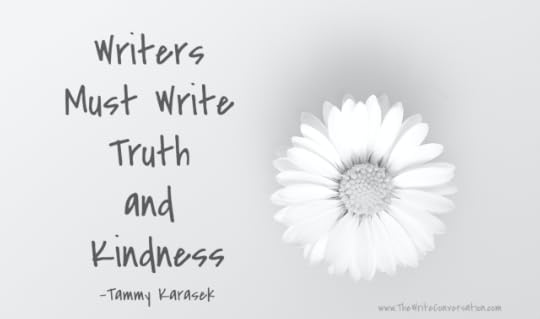
by Tammy Karasek @TickledPinkTam
What a year 2020 has been so far. With the mandate of staying home for the majority of people, I’ve heard from many writers about what this time of inactivity has done for them or even how it has changed them. They’ve shared about personal reflection on their lives, to setting new priorities and even a change of goals. Several writer friends have admitted to a shake up from what they’ve been doing to something even better.I’ve also had some soul searching, priority rearranging and downright on my knees seeking direction from God on my future writing journey these past several months. Maybe you have done so as well.
Sadly though, many moments have been spent at my keyboard typing a response to a person’s hurtful or derogatory comments only to then delete the entire comment I’ve typed. I’ve clicked on like on a post on a social media site only to quickly unlike it. Who am I to correct someone’s mean comment or agree with another’s controversial stand? I’ve felt shame.
You might ask why this is bothering me so much. And I’ve pondered how I wanted to write this post in a way that first and foremost encourages you as a writer. Then secondly challenges myself to be better at sharing the love of Christ through my words.
I have been hurt deep in my soul watching Christian writers spew sharp words out into the cyber world these last few weeks. And I’ve thought, how terrible of them.
Then the light bulb moment came for me.
I may not have written my comments or agreed with the post publically, but am I free of guilt?
I wish I could tell you a confident no. But in total transparency, I am guilty, too. As a writer, it hit me hard that with the spot the Lord has me in to share words, that those words—or thoughts—may not be so pleasing to the Lord.
I went to the best book ever written for some instruction and encouragement and I’m sharing what the Lord brought to my attention. May you be uplifted by these words from God.
“but no human being can tame the tongue. It is a restless evil, full of deadly poison. With it we bless our Lord and Father and with it we curse people who are made in the likeness of God. From the same mouth come blessing and cursing. My brothers these things ought not to be so.” (James 3:8-10 ESV)
In the likeness of God. Ouch, my thoughts and words were like slinging them at God. As writers and speakers, we have the greatest opportunity to speak love and kindness through the words the Lord gives to us. Let us not bless and curse from our platform—let’s stay in the bless the people frame of mind.
“Let the words of my mouth and the mediation of my heart be acceptable in your sight, O Lord, my rock and my redeemer.” (Psalm 19:14 ESV)
Oh, Lord, please let these come to my mind before I write or speak. Please make me so focused on you, that my words and mediation of my heart align with your message of hope to all people. ALL people.
“To speak evil of no one, to avoid quarreling, to be gentle, and to show perfect courtesy toward all people.” (Titus 3:2 ESV)
Yes! This. And again God tells us ALL people.
For sure 2020 has been one of the most difficult and confusing years I’ve ever lived through. Maybe you feel the same way. It doesn’t look like we’re done yet. Through all of this, I have been reminded over and over again about what a huge responsibility I (we) have as writers. We hold great power in our words. Many of us have huge platforms and people will watch to see how we react. Those of us who have small or very small platforms think we are safe from observers, but we are most certainly not.
My advice to myself and maybe a reminder to you is that we grab hold of this opportunity as writers to use our words to show Christ’s love to ALL people. While we might not be able to give physical hugs just yet, we most certainly can give someone a hug through our written words. A kind and uplifting comment. An atta-boy or atta-girl for someone who achieved a goal. Let Christ so shine through your words that people want more of Him.
I have some work on myself to do, but I still have time at home to ponder my next action to fix what’s broken in me. In the meantime …
I pray your words warm the hearts of all who read them. May God bless your work.
TWEETABLEWriters Must Write Truth and Kindness - @TickledPinkTam on @EdieMelson (Click to Tweet)
 You’ll find Tammy seeing humor and causing laughter in every aspect of life. Her past, filled with bullying and criticism from family, is the driving force of her passion to always encourage others and give them The Reason to smile. She’s been married to her college sweetheart, Larry, for 37 years, a mom to their grown daughter, Kristen, and wrapped around the paw of a little dog named Hattie. Born and raised in Ohio, her family now resides in South Carolina. She is the President of Word Weavers Upstate SC, member of ACFW and My Book Therapy/Novel Academy. She’s the Blog Editor for Word Weavers International. A Conference Assistant for Blue Ridge Christian Writers Conference. A monthly contributor for The Write Conversation. A contributor in the 2018 Divine Moments Compilation Book—Cool-inary Moments. Also a regular contributor to several other blogs.
You’ll find Tammy seeing humor and causing laughter in every aspect of life. Her past, filled with bullying and criticism from family, is the driving force of her passion to always encourage others and give them The Reason to smile. She’s been married to her college sweetheart, Larry, for 37 years, a mom to their grown daughter, Kristen, and wrapped around the paw of a little dog named Hattie. Born and raised in Ohio, her family now resides in South Carolina. She is the President of Word Weavers Upstate SC, member of ACFW and My Book Therapy/Novel Academy. She’s the Blog Editor for Word Weavers International. A Conference Assistant for Blue Ridge Christian Writers Conference. A monthly contributor for The Write Conversation. A contributor in the 2018 Divine Moments Compilation Book—Cool-inary Moments. Also a regular contributor to several other blogs. Connect with Tammy: Blog: http://www.tammykarasek.com Email: tickledpinktammy@gmail.com
Published on June 20, 2020 22:00
June 19, 2020
The Christian Writer as an Apologist
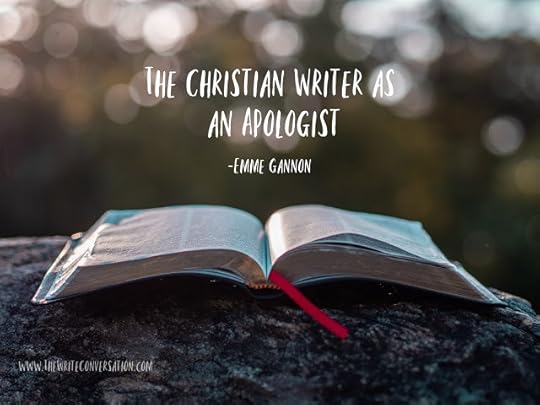
by Emme Gannon @GannonEmme
The world recently lost one of the most respected of modern day apologists, or pre-evangelist, as they are sometimes referred. Ravi Zacharias traveled the world passionately using reason and evidence to bring the reality of Christ to those whose mantra often is, “Each person dictates what is true,” or, as scripture puts it, “They all did what was right in their own eyes.”The foundational truth that apologists seek to covey is:Truth existsGod existsMiracles are possibleThe Bible is historically trueJesus has risen from the dead
How can a writer establish truth and communicate in ways that expose hatred and wrong thinking? Look no farther than the earthly ministry of Jesus, the greatest apologist of all time. He used reason and evidence to present truth. He challenged unbelief. He exposed errors. He defended the message of the gospel.
Jesus often illustrated His message through story—stories that captivated and taught truth. Stories that crashed through selfish motives into the hearts of His listeners, many of whom were only there to bait Him and try to expose Him as a fraud.
One such story is that of the Good Samaritan. A lawyer, who was trying to test Jesus and justify himself, asked Him, “Who is my neighbor?” Jesus answered with the story of a man traveling from Jerusalem to Jericho who was viciously attacked, robbed, beaten, and left “half dead.” A priest saw him and passed by. Likewise, a Levite. Then came a Samaritan, hated by the Jews. It was the Samaritan who stopped and treated his wounds, then took him to an inn to recover, where he paid for his care. Jesus ends the story with a question, “So which of these three do you think was neighbor to him who fell among the thieves?” The lawyer said, “He who showed mercy to him.” Then Jesus said to him, “Go and do likewise.”
As our nation reels from the senseless and cruel death of George Floyd, there are those who have hijacked legitimate and peaceful protests and turned them into rioting, violence, and looting—unmercifully destroying their neighbor’s businesses, livelihoods, and, sometimes even taking their lives. They ravage and leave “half dead” their neighbors and their property. Driven by hate, they pronounce a death sentence on all who seek to keep law and order because of the evil deeds of a few.
How can we who know and love the Lord stand up to such evil as wandering mobs whose mission is to eradicate and destroy? We’ve only to look to Jesus and those who have gone before us. Our battle is always against sin that is perpetuated by evil. The Christian apologist does not allow sin to intimidate but, instead, faces the darkness. We humbly stand upright, armed with the Word of God and the words He has poured into our hearts. We boldly proclaim God’s truth. Truth that all races are a sacred gift from God.
God’s first commandment is “Love the Lord your God with all your heart and with all your soul.” Only by loving the Lord your God with all your heart and your soul can you keep the second commandment, “Love your neighbor as yourself.” Hatred cannot dwell in a heart that is yielded and possessed by God.
We are not told if the lawyer Jesus spoke with allowed Jesus to change his heart. But the message had been given, light pierced the darkness of his soul, and he had to choose to live in the light of God’s Word, or return to the place from which he had been.
Still, we persevere. We place our readers into situations where they are allowed to experience truth. We pray that hardened hearts will be pierced by the Holy Spirit of the Living God. Changing hearts. Changing lives. Changing communities. We write. We pray. And we remember that following Christ often brings tribulation. Still, we continue to humbly bring His light and love to a world darkened by sin. For that is what we’re called to do.
TWEETABLEThe Christian Writer as an Apologist - @GannonEmme on @EdieMelson (Click to Tweet)
 Emme Gannon is a wife, mother, and grandmother who loves to write stories that stir the heart. Her award-winning writing has appeared in Focus on the Family magazine, several anthologies, and numerous newsletters. She just completed her first novel.
Emme Gannon is a wife, mother, and grandmother who loves to write stories that stir the heart. Her award-winning writing has appeared in Focus on the Family magazine, several anthologies, and numerous newsletters. She just completed her first novel.
Published on June 19, 2020 22:00
June 18, 2020
No More Writing Rejections
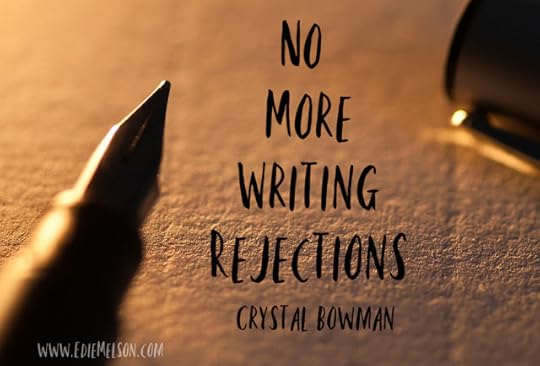
by Crystal Bowman
I have been writing for more than twenty-five years, and since I write mostly for children, I’ve been able to write more than 100 books. If I were writing novels, that number would be closer to zero. Like all writers, I’ve received my share of rejections, but I don’t get them anymore and I’ll tell you why. I don’t like the word “rejection.” Whether it pertains to a relationship, a hopeful job interview, or a manuscript, it’s just not a nice word. So I don’t use it anymore. Instead, I have replaced it with the word redirection.
When a submitted manuscript doesn’t result in a contract, it isn’t necessarily because the manuscript was poorly written. Many times, a publisher turns down a manuscript because it isn’t a good fit for their company. Publishing companies have production goals and specialize in certain genres, so wise writers will do their homework and submit to a publisher that’s a good match. This will increase the chances of receiving a contract.
I recently submitted a board book proposal to a publishing house that I thought was a good fit. It was such a good fit that they had just offered a contract for a similar book to another writer. They loved my story and said to send proposals anytime, but they would not publish this one. Since I did not receive a contract from them, my agent submitted it to another publisher, and I received a contract. My proposal was not rejected, it was redirected.
In my early days of writing, I wrote a picture book manuscript about animals preparing for winter. Even though I received positive feedback from several publishers, it ended up in my “not yet published” file for years. When I started writing for Clubhouse Jr. Magazine, I revisited the story and sent it to the editor. They published it on a two-page spread with adorable illustrations and interactive questions. The payment was less than I would have received from a book contract, but they have nearly 50,000 subscribers. Many picture books sell fewer than 2 or 3 thousand, and it was more important to me (and my résumé) to reach a larger audience.
When I teach at writers’ conferences, I caution novice writers against sending in a manuscript before it’s ready to submit. Here are a few simple tips:Take an online class, attend a workshop, or read a book on how to format your manuscript and write a professional proposal. Have your work professionally edited. Study the publisher’s submission guidelines and follow them exactly.Have a clear explanation of why your book meets a need in the market. As most writers know, writing for publication in not for the faint of heart. You need the skin of a rhinoceros and the determination of a salmon swimming upstream. Even bestselling authors have their work redirected, so if you receive a “no thank you” from a publisher, don’t be discouraged, just follow the 4 Ps: persistence, patience, positive attitude, and prayer.
My next picture book will release this October. It’s based on a true story about a grandma who develops dementia. I love You to the Stars—When Grandma Forgets, Love Remembers, was redirected seven times in the past three years and finally landed in a good publishing house.
I no longer receive rejections because I refuse to use that word. How about you?
TWEETABLENo More Writing Rejections - Crystal Bowman on @EdieMelson (Click to Tweet)
 Crystal Bowman is an award-winning, bestselling author of more than 100 books for children and four nonfiction books for women. She also writes lyrics for children’s piano music and is a monthly contributor to Clubhouse Jr. Magazine. She loves going to schools to teach kids about poetry. She also speaks at MOPS (Mothers of Preschoolers) groups and teaches workshops at writers’ conferences. When she is not writing or speaking, she enjoys going for walks, working out at the gym, and eating ice cream. She and her husband live in Michigan and have seven huggable grandkids. www.crystalbowman.comwww.facebook.com/crystal.bowmanwww.facebook.com/crystaljbowmanwww.Instagram.com/crystalbowmanauthor
Crystal Bowman is an award-winning, bestselling author of more than 100 books for children and four nonfiction books for women. She also writes lyrics for children’s piano music and is a monthly contributor to Clubhouse Jr. Magazine. She loves going to schools to teach kids about poetry. She also speaks at MOPS (Mothers of Preschoolers) groups and teaches workshops at writers’ conferences. When she is not writing or speaking, she enjoys going for walks, working out at the gym, and eating ice cream. She and her husband live in Michigan and have seven huggable grandkids. www.crystalbowman.comwww.facebook.com/crystal.bowmanwww.facebook.com/crystaljbowmanwww.Instagram.com/crystalbowmanauthor
Published on June 18, 2020 22:00
June 17, 2020
Fighting Pandemic Burnout
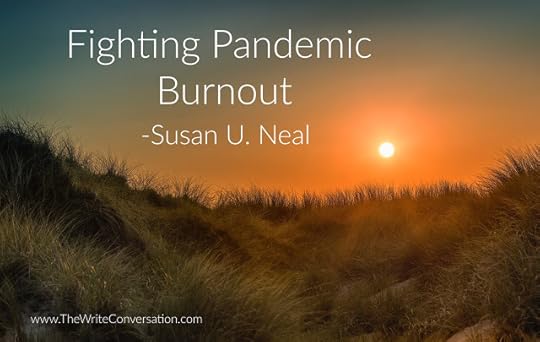
by Susan U. Neal RN, MBA, MHS @SusanNealYoga
I don’t know about you, but this pandemic has affected me more than I thought. Extra kids and family at home, cooking every meal, dishes, constant interruptions, speaking cancellations along with ensuing deadlines affected me emotionally, spiritually, physically, and financially. Not to mention the stress and fear of potentially contracting Covid-19 and praying for my friend who was fighting it. Has the pandemic affected you too?Burnout is caused by long-term, unrecognized, unprocessed chronic stress. It is exhibited through fatigue, lack of motivation and interest in work, and thoughts such as your work doesn’t matter. Have you felt like your writing doesn’t matter? With burnout, you may disconnect from family and friends, which happened to most of us with the quarantine. I finally recognized that I was suffering from these symptoms.
Tina Yeager, a Licensed Mental Health Counselor writes, “The pandemic has exposed us to multiple layers of stress. Individuals may have grieved the losses of loved ones, jobs, security, or health. Most of us have suffered at some level from the emotional strain of isolation, which science has documented as a critical blow to mental health. In addition to heartbreak and disconnection, we also suffer from collective trauma during a pandemic, war, or natural disasters.”
Additionally Tina explains, “Trauma overwhelms the brain and disrupts our ability to adapt or cope. Therefore, this pandemic's multifaceted attack upon our well-being can send us into burnout before we realize what we're experiencing. The pandemic can spiral our minds into depression, despair, and anxiety. Self-care takes on the highest priority in times of crisis, like our current season.”
Edie Melson writes in Soul Care for Writers , “There are very few of us who wouldn’t go see a doctor when we’re ill. But for some reason, when our souls are ailing, we often avoid seeking out the recommendations of our heavenly physician.” During this pandemic I didn’t seem to have the time to do a daily devotion and meditate with the Lord. Did you? I had breakfast to cook and dishes to do, plus all the work that I was lagging in because of constant interruptions from family members who were home. Did your spiritual life suffer due to the pandemic also?
Edie Melson’s scripture prescriptions in Soul Care When You’re Weary spoke to me.
Then Jesus said, “Let’s go off by ourselves to a quiet place and rest awhile.”Mark 6:31 (NIV)
Cast all your anxiety on him because he cares for you.1 Peter 5:7 (NIV)
The Lord replied, “My Presence will go with you, and I will give you rest.”Exodus 33:14 (NIV)
Starting today, I am determined to spend time with the Lord every morning on my front porch. I need to cast my worries and cares on God and believe that his presence will go with me and give my heart ultimate rest. I need spiritual restoration that only He can provide. How about you? Do you need some soul care?
Tina Yeager suggests that we monitor our exposure to negative messages or media, which could intensify our trauma symptoms. Nourishment and sleep prove vital to survival and recovery. Positive activities like writing, art, and nature walks ground us. Prayer, scripture meditation, and supportive fellowship anchor us through the storms of trauma. In addition to these essential parts of your emergency trauma kit, reach out as needed. Contact a local therapist or national hotline (SAMHSA, for example) for help if you feel unable to cope.
To help you recover from the impact of the Coronavirus crisis upon your life, join us for a virtual conference, A Little SHE Time: A Women's Renewal Event, which takes place Friday, June 26 and Saturday, June 27, 2020, or Rebound Your Highest: Come Back Stronger After the Struggle which will livestream on July 25-26, 2020. We have suffered from trauma through this pandemic. But we can find rest with the Lord. May God bless you and renew you during this season of restoration.
TWEETABLEFighting Pandemic Burnout - tips and encouragement from @SusanNealYoga on @EdieMelson (Click to Tweet)
 Susan U. Neal, RN, MBA, MHSSusan’s mission is to improve the health of the body of Christ. She has her RN and MBA degrees, as well as a master’s in health science. She is a CERTIFIED HEALTH AND WELLNESS COACH with the American Association of Christian Counselors. She published five books, the Selah award winner 7 STEPS TO GET OFF SUGAR AND CARBOHYDRATES, CHRISTIAN STUDY GUIDE FOR 7 STEPS TO GET OFF SUGAR AND CARBOHYDRATES, HEALTHY LIVING JOURNAL, SCRIPTURE YOGA a #1 Amazon best-selling yoga book, and YOGA FOR BEGINNERS which ranked #3. She published two sets of Christian Yoga Card Decks and two Christian Yoga DVDs that are available at CHRISTINAYOGA.COM. Her digital product HOW TO PREVENT, IMPROVE, AND REVERSE ALZHEIMER’S AND DEMENTIA is a great resource. To learn more about Susan visit her website SUSANUNEAL.COM You can also connect with Susan on FACEBOOK, TWITTER, and INSTAGRAM.
Susan U. Neal, RN, MBA, MHSSusan’s mission is to improve the health of the body of Christ. She has her RN and MBA degrees, as well as a master’s in health science. She is a CERTIFIED HEALTH AND WELLNESS COACH with the American Association of Christian Counselors. She published five books, the Selah award winner 7 STEPS TO GET OFF SUGAR AND CARBOHYDRATES, CHRISTIAN STUDY GUIDE FOR 7 STEPS TO GET OFF SUGAR AND CARBOHYDRATES, HEALTHY LIVING JOURNAL, SCRIPTURE YOGA a #1 Amazon best-selling yoga book, and YOGA FOR BEGINNERS which ranked #3. She published two sets of Christian Yoga Card Decks and two Christian Yoga DVDs that are available at CHRISTINAYOGA.COM. Her digital product HOW TO PREVENT, IMPROVE, AND REVERSE ALZHEIMER’S AND DEMENTIA is a great resource. To learn more about Susan visit her website SUSANUNEAL.COM You can also connect with Susan on FACEBOOK, TWITTER, and INSTAGRAM.
Published on June 17, 2020 22:00
June 16, 2020
10 Tips for Irresistible Writing, Part 3
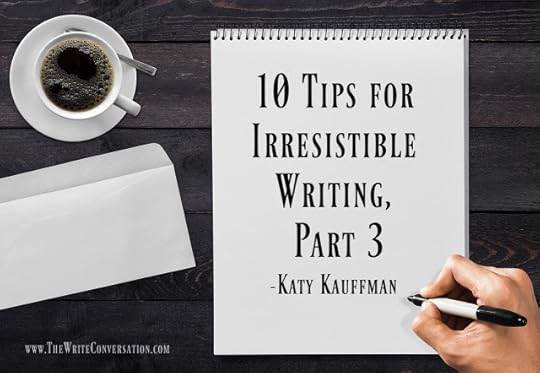
by Katy Kauffman @KatyKauffman28
Have you ever been watching a movie and it had a great beginning, but then it petered out somewhere in the middle? The middle must be the toughest to write. You decide to get some extra popcorn to help you keep watching because you want to know what happens. The ending is pretty satisfying, but (as a writer) you think that the middle could have used some extra TLC.In this post, I would like to share three tips that will not only help the middle sections of your writing, but make all of your writing infused with “punch, zip, and wow”—to say something that is both inspiring and powerful, to-the-point, and enriching.
Tip #6: Don’t just rehash Scripture in your writing—find a unique way to present it.
Anyone can provide a summary of what Scripture says, but irresistible writing presents Scripture with creativity. Does your Bible passage have its own word picture? Share a personal experience related to that metaphor as you explain the verses. Is there an intriguing slant that you can use to introduce a familiar story? Keep the reader’s interest by using that angle to introduce and explain the passage.
For example, in John 10:27, Jesus talked about His sheep recognizing His voice and following Him. If I were to write about this passage, I would share about the time in Europe that my family sat in a restaurant overlooking a valley. We watched as two shepherds came together in the valley to chat and their flocks mixed. How would they ever separate their sheep? As the shepherds headed in different directions and called to their flocks, it looked like the parting of the Red Sea. Each sheep knew who it belonged to and didn’t hesitate to follow.
Tip #7: See if any paragraphs, sentences, or words can be left out and your message is still clear.
No, don’t say that! I cringe inwardly when I hear a faculty member at a writer’s conference say, “We have to kill our darlings.” I prefer to gently paste them into a cozy Word file for later.
To create irresistible writing, read every paragraph, and see if it’s needed. Copy and paste those precious paragraphs that aren’t, into a new file. Then see if every sentence in the remaining paragraphs is needed. Delete whatever doesn’t detract from the clarity of your message. (The reader will never know.) Then look at each word in your sentences. If something can be said with fewer words, go for it. If a word doesn’t serve a good purpose, say good-bye. Make sure every word, sentence, and paragraph progress your main idea and don’t just take up space.
Tip #8: Track your flow of thought by reading the first line of every paragraph.
This helps your main point to be understood from beginning to end. The first lines of your paragraphs act like stepping stones for the reader. Whether I am evaluating someone else’s submission or my own writing, I often read the first lines of the paragraphs to see the progression of the main point. My heart is quite satisfied when my own first lines show the flow of thought traveling in a straight line (not the kind of line that meanders on the side of a mountain).
We want to take our readers from Point A to Point B on the fastest route possible. They’ll appreciate it. We can definitely make the trip beautiful, but having a straightforward flow of thought will help keep our writing enjoyable and irresistible.
Which do you appreciate the most in someone else’s writing—unique insights about Scripture, streamlined writing, or an understandable flow of thought? Tell us in the comments below, and join the conversation!
TWEETABLE10 Tips for Irresistible Writing, Part 3 - @KatyKauffman28 on @EdieMelson (Click to Tweet)
Don’t Miss the Rest of This Series!10 Tips for Irresistible Writing, Part 110 Tips for Irresistible Writing, Part 210 Tips for Irresistible Writing, Part 3
 Katy Kauffman is an award-winning author, an editor of Refresh Bible Study Magazine, and a co-founder of Lighthouse Bible Studies. She loves connecting with writers and working alongside them in compilations, such as Feed Your Soul with the Word of God, Collection 1 which is a 2020 Selah Awards finalist. Lighthouse’s newest compilation, The Power to Make a Difference, released January 2020.
Katy Kauffman is an award-winning author, an editor of Refresh Bible Study Magazine, and a co-founder of Lighthouse Bible Studies. She loves connecting with writers and working alongside them in compilations, such as Feed Your Soul with the Word of God, Collection 1 which is a 2020 Selah Awards finalist. Lighthouse’s newest compilation, The Power to Make a Difference, released January 2020. In addition to online magazines, Katy’s writing can be found at CBN.com, thoughts-about-God.com, the Arise Daily blog, and two blogs on writing. She loves spending time with family and friends, making jewelry, and hunting for the best donuts. Connect with her at her blog, The Scrapbooked Bible Study, and on Facebook and Twitter.
Published on June 16, 2020 22:00



